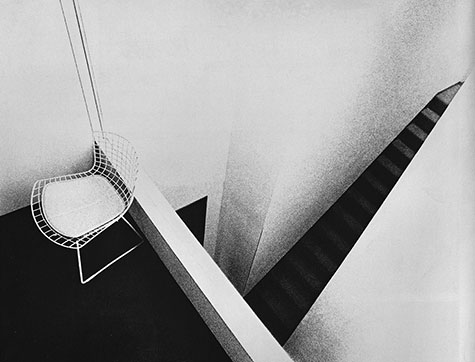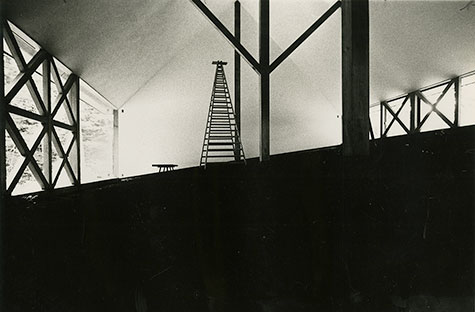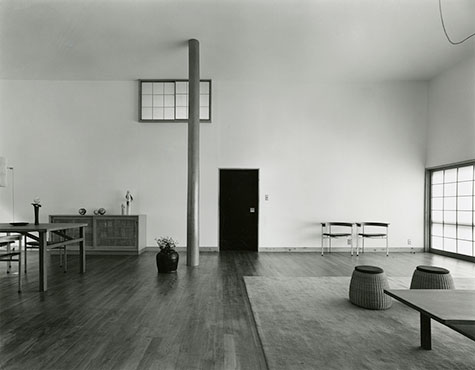
“A house is a work of art.”
So declared Shinohara Kazuo (1925-2006), one of the most influential figures in postwar international modernism. And in Shinohara’s hands, it was. Projects such as Kugayama House (1952-54) and Umbrella House (1959-61) combined rigorous geometry with traditional Japanese forms to create purist, poetic structures of modest scale but vast ambition.
Yet Shinohara remains something of a cult figure. Although his works have inspired generations of architects, they have seldom been seen outside Japan.
Now, this mathematician-turned-architect is finally receiving his first U.S. museum exhibition. Organized by the Mildred Lane Kemper Art Museum at Washington University in St. Louis, “On the Thresholds of Space-Making: Shinohara Kazuo and His Legacy” features original drawings, sketches, period photographs and other archival material — much of which never has been publicly displayed before.
Drawn largely from the Shinohara Kazuo Archive at the Tokyo Institute of Technology, “On the Thresholds of Space-Making” is curated by Seng Kuan, PhD, assistant professor of architectural history in WUSTL’s Sam Fox School of Design & Visual Arts.
“With such projects as House in White (1964–66), Shinohara reinvented established forms of the single-family dwelling,” Kuan said. Familiar design elements — a square plan, a pointed roof, white walls and a center post — are infused with a new sense of abstraction, detailing and symbolism.
The result “gives the traditional Japanese great room an almost oceanic spaciousness.”

The Shinohara School
Born in Shizuoka, Shinohara studied and briefly taught mathematics but soon enrolled in Tokyo Institute of Technology’s architecture program. After graduation, in 1953, he joined the faculty and remained there until retirement, in 1986.
“Shinohara conducted his design work exclusively through the university laboratory rather than through a private atelier,” Kuan explained. “This lifelong research-driven approach allowed him to focus singularly and exhaustively on theoretical concerns.”
Those concerns included scrutinizing and reframing a series of fundamental architectural dualities: public and private, bigness and smallness, openness and enclosure, chaos and order.
“Shinohara’s pioneering body of work and theoretical investigations of space-making are a touchstone for architects both in Japan and abroad,” Kuan said. His sustained methodological and typological rigor “have played a key role in shaping Japan’s history of leadership in architectural innovation.”
To demonstrate that legacy, “On the Thresholds of Space-Making” includes a sampling of works by contemporary Japanese architects who have acknowledged intellectual indebtedness to Shinohara. Featured are projects by the Pritzker Prize-winner Toyō Itō (b. 1941) as well as Nishizawa Ryue (b. 1966) of the firm SANAA; Atelier Bow-Wow; and Ishigami Junya (b. 1974) — all recognized as global leaders of contemporary design.
“By juxtaposing Shinohara’s work with that of subsequent generations, we see a clear lineage that constitutes a highly energized collective of creative talent,” Kuan said. “These architects pushed the frontiers of architectural design, unrivaled in their intellectual rigor and stylistic coherence in contemporary global practice.”

Mildred Lane Kemper Art Museum
“On the Thresholds of Space-Making” remains on view through April 20. The Kemper Art Museum is located on Washington University in St. Louis’ Danforth Campus, near the intersection of Skinker and Forsyth boulevards. Regular hours are 11 a.m. to 5 p.m. daily; 11 a.m. to 8 p.m. first Friday of the month. The museum is closed Tuesdays.
For more information, call 314-935-4523; visit kemperartmuseum.wustl.edu; or follow the museum on Facebook and Twitter.
Support for the exhibition is provided by the Sam Fox School of Design & Visual Arts and College of Architecture; the Japan Foundation; the Graham Foundation for Advanced Studies in the Fine Arts; and members of the Kemper Art Museum.
